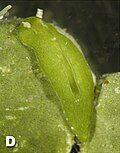Search results
Appearance
Did you mean: micrometre
The page "Micromere" does not exist. You can create a draft and submit it for review or request that a redirect be created, but consider checking the search results below to see whether the topic is already covered.
- Johnstonella micromeres is a species of flowering plant in the family Boraginaceae known by the common name pygmyflower cryptantha. It is native to California...3 KB (138 words) - 15:59, 8 January 2024
- successive cleavage cycle, the macromeres give rise to quartets of smaller micromeres at the animal pole. The divisions that produce these quartets occur at...26 KB (2,994 words) - 06:34, 26 August 2024
- adult's broadly fivefold symmetry. During cleavage, mesoderm and small micromeres are specified. At the end of gastrulation, cells of these two types form...80 KB (8,034 words) - 14:14, 27 September 2024
- unequally and they give rise to four big macromeres and four smaller micromeres. Once this fourth division has occurred, the embryo has reached a 16 cell...25 KB (2,705 words) - 16:04, 11 October 2024
- 2a, 2c, 3c and 3d cells. The shell plates arise primarily from the 2d micromere, although 2a, 2b, 2c and sometimes 3c cells also participate in its secretion...50 KB (4,840 words) - 22:51, 16 October 2024
- unequal cleavage resulting in three cell types, small, medium and large (micromeres, mesomeres, megameres). Megameres develop into a syncytial layer, the...35 KB (4,259 words) - 16:14, 31 August 2024
- anterior/posterior axis lies along the animal/vegetal axis set up during cleavage. The micromeres induce the nearby tissue to become endoderm while the animal cells are...33 KB (5,170 words) - 20:53, 16 September 2024
- jamesii → Oreocarya suffruticosa var. suffruticosa Cryptantha micromeres → Johnstonella micromeres Cryptantha nubigena → Oreocarya nubigena Cryptantha pustulosa...9 KB (701 words) - 21:43, 20 March 2024
- euechinoid embryonic development, e.g. in the purple sea urchin, the micromeres comprise a set of four small cells that reside at the base of the vegetal...12 KB (1,262 words) - 19:31, 1 October 2024
- Roy J.; Davidson, Eric H. (1980). "Limited complexity of the RNA in micromeres of sixteen-cell sea urchin embryos". Developmental Biology. 79 (1): 119–127...6 KB (608 words) - 20:15, 20 March 2024
- the end of stage 3 the AB cell divides. On stage 4 of development, the micromeres and teloblast stem cells are formed and subsequently, the D quadrant divides...5 KB (713 words) - 08:14, 18 August 2023
- "Extending the methodology of x-ray crystallography to allow imaging of micromere-sized non-crystalline specimens". Nature. 400 (6742): 342–344. Bibcode:1999Natur...29 KB (3,759 words) - 18:58, 26 September 2024
- while descendants of the first quartet micromeres give rise to structures in the larval head. When micromere 2d is laser ablated, 2d derived structures...38 KB (4,604 words) - 01:29, 26 April 2024
- the primary mesenchyme cells (PMCs), the sole descendants of the large micromere daughter cells, undergo an epithelial–mesenchymal transition (EMT) and...10 KB (1,228 words) - 03:46, 18 May 2024
- holoblastic. This means that the upper tier of the animal's cells, called micromeres, are situated at a 45° angle to the lower tier of the macromeres. This...16 KB (1,903 words) - 22:57, 15 January 2024
- Johnstonella mexicana (Brandegee) M.E.Mabry & M.G.Simpson Johnstonella micromeres (A.Gray) Hasenstab & M.G.Simpson Johnstonella parviflora (Phil.) Hasenstab...5 KB (565 words) - 07:51, 30 July 2024
- From micro- + -mere. micromere (plural micromeres) An unusually small blastomere formed by unequal cleavage of a fertilized ovum.
- unequal, producing macromeres and micromeres marked by differences in the size and in yolk-contents. The micromeres give rise to the ectoderm; each of










